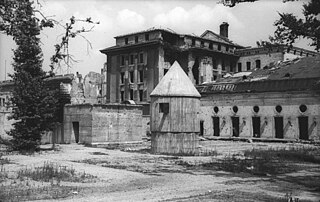
The Führerbunker was an air raid shelter located near the Reich Chancellery in Berlin, Germany. It was part of a subterranean bunker complex constructed in two phases in 1936 and 1944. It was the last of the Führer Headquarters (Führerhauptquartiere) used by Adolf Hitler during World War II.

Adolf Hitler, chancellor and dictator of Nazi Germany from 1933 to 1945, committed suicide via a gunshot to the head on 30 April 1945 in the Führerbunker in Berlin after it became clear that Germany would lose the Battle of Berlin, which led to the end of World War II in Europe. Eva Braun, his wife of one day, also committed suicide by cyanide poisoning. In accordance with Hitler's prior written and verbal instructions, that afternoon their remains were carried up the stairs and through the bunker's emergency exit to the Reich Chancellery garden, where they were doused in petrol and burned. The news of Hitler's death was announced on German radio the next day, 1 May.

Blondi was Adolf Hitler's German Shepherd, a gift as a puppy from Martin Bormann in 1941. Hitler kept Blondi even after his move into the Führerbunker located underneath the garden of the Reich Chancellery on 16 January 1945.
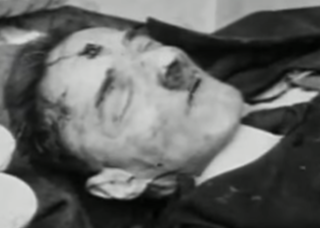
Although there is no evidence that Nazi dictator Adolf Hitler used look-alikes as political decoys during his life, some stories propagated as early as 1939 assert his death and replacement with an imposter. Following Hitler's suicide during the Battle of Berlin, the Soviet Union claimed to discover a number of bodies resembling the dictator, bolstering a disinformation campaign asserting Hitler's survival. Only the dental remains of the dictator or Eva Hitler were positively identified.
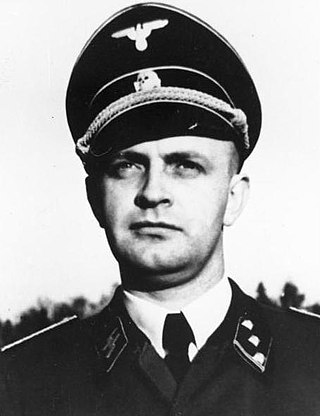
Heinz Linge was a German SS officer who served as a valet for the leader of Nazi Germany, Adolf Hitler, and became known for his close personal proximity to historical events. Linge was present in the Führerbunker on 30 April 1945, when Hitler committed suicide. Linge's ten-year service to Hitler ended at that time. In the aftermath of the Second World War in Europe, Linge spent ten years in Soviet captivity.

The Bunker, also published as The Berlin Bunker, is a 1975 account, written by American journalist James P. O'Donnell and German journalist Uwe Bahnsen, as to the history of the Führerbunker in 1945, as well as the last days of German dictator Adolf Hitler. The English edition was first published in 1978. Unlike other accounts O'Donnell focused considerable time on other, less-famous, residents of the bunker complex. Additionally, unlike the more academic works by historians, the book takes a journalistic approach. The book was later used as the basis for a 1981 CBS television film of the same name.

Rochus Misch was a German Oberscharführer (sergeant) in the 1st SS Panzer Division Leibstandarte SS Adolf Hitler (LSSAH). He was badly wounded during the Polish campaign during the first month of World War II in Europe. After recovering, from 1940 to April 1945, he served in the Führerbegleitkommando as a bodyguard, courier, and telephone operator for German dictator Adolf Hitler.

Ernst-Günther Schenck was a German medical doctor and member of the SS in Nazi Germany. Because of a chance encounter with Adolf Hitler during the closing days of World War II, his memoirs proved historically valuable. His accounts of this period are prominent in the works of Joachim Fest and James P. O'Donnell regarding the end of Hitler's life, and were included in the film Downfall (2004). Schenck was not allowed to continue his medical career in post-war Germany.

Erich Kempka was a member of the SS in Nazi Germany who served as Adolf Hitler's primary chauffeur from 1936 to April 1945. He was present in the area of the Reich Chancellery on 30 April 1945, when Hitler shot himself in the Führerbunker. Kempka delivered petrol to the garden behind the Chancellery, where the remains of Hitler and Eva Braun were burned. After Kempka's capture by United States forces, he served as an eyewitness as to Hitler's demise, albeit his self-admitted unreliability.
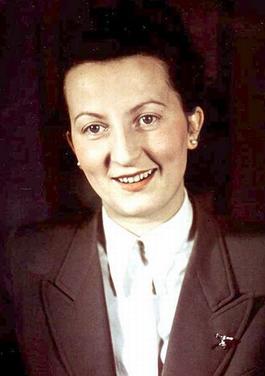
Gerda Christian, nicknamed Dara, was one of Adolf Hitler's private secretaries before and during World War II.

Eva Anna Paula Hitler was a German photographer who was the longtime companion and briefly the wife of Adolf Hitler. Braun met Hitler in Munich when she was a 17-year-old assistant and model for his personal photographer, Heinrich Hoffmann. She began seeing Hitler often about two years later.
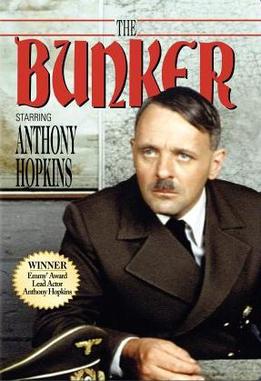
The Bunker is a 1981 American made-for-television historical war film produced by Time-Life Productions based on the 1975 book The Bunker by James P. O'Donnell.

Else Krüger was Martin Bormann's secretary from the end of 1942 until 1 May 1945. She was born in Hamburg-Altona.
James Preston O'Donnell was an American author and journalist.

The Berkut is a 1987 secret history novel by Joseph Heywood in which Adolf Hitler survives World War II. It is set in the period immediately after the fall of the Third Reich. This book pits a German colonel and a Russian soldier from a secret organization against each other. The German, Günter Brumm, has been given orders to safely get the Führer out of Germany with the remaining resources of the Reich at his disposal, while Vasily Petrov, the Russian, has been given orders by Joseph Stalin to capture Hitler with the full resources of the Soviet Union at his disposal. In essence, Hitler says "Get me out of Germany, alive", while Stalin says, "Get me Hitler, alive." The book explores Brumm and Petrov pursuing their goals.
The Hitler family comprises the relatives and ancestors of Adolf Hitler, an Austrian-born German politician and the leader of the Nazi Party, who was the dictator of Germany, holding the title Chancellor of Germany from 1933 to 1945, and head of state as Führer und Reichskanzler from 1934 to 1945. Adolf Hitler had a central role in the rise of Nazism in Germany, provoking the start of World War II, and holding ultimate responsibility for the deaths of many millions of people during the Holocaust.
Ewald Lindloff was a Waffen-SS officer during World War II, who was present in the Führerbunker on 30 April 1945, when Hitler committed suicide. He was placed in charge of disposing of Hitler's remains. Lindloff was later killed during the break-out on 2 May 1945 while crossing the Weidendammer Bridge under heavy fire in Berlin.
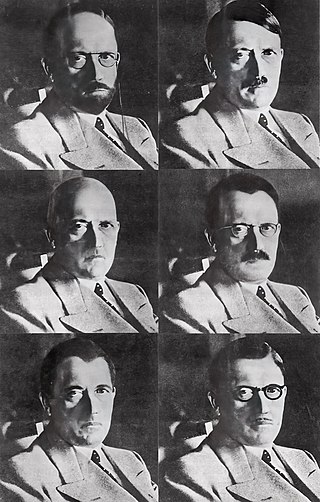
Fringe and conspiracy theories about the death of Adolf Hitler, dictator of Germany from 1933 to 1945, contradict the accepted fact that he committed suicide in the Führerbunker on 30 April 1945. Stemming from a campaign of Soviet disinformation, most of these theories hold that Hitler and his wife, Eva Braun, survived and escaped from Berlin, with some asserting that he went to South America. In the post-war years, the United States Federal Bureau of Investigation (FBI) and Central Intelligence Agency (CIA) investigated some of the reports, without lending them credence. The 2009 revelation that a skull in the Soviet archives long (dubiously) claimed to be Hitler's actually belonged to a woman has helped fuel fringe theories.

The Death of Adolf Hitler: Unknown Documents from Soviet Archives is a 1968 book by Soviet journalist Lev Bezymenski, who served as an interpreter in the Battle of Berlin. The book gives details of the purported Soviet autopsies of Adolf Hitler, Eva Braun, Joseph and Magda Goebbels, their children, and General Hans Krebs. Each of these individuals are recorded as having died by cyanide poisoning; contrary to the Western conclusion that Hitler died by a suicide gunshot.

Who Killed Hitler? is a 1947 American book edited by Herbert Moore and James W. Barrett, with an introduction by U.S. intelligence officer William F. Heimlich. The book contends that rather than commit suicide or escape Germany, Nazi leader Adolf Hitler was assassinated in an attempted coup d'état by Schutzstaffel (SS) leader Heinrich Himmler.

















